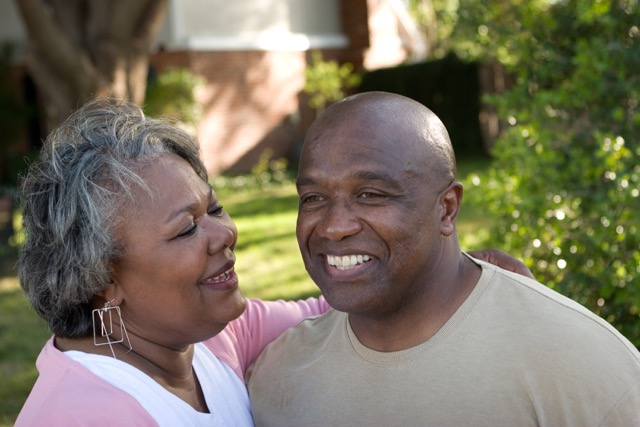Male/female disparities within the older adult population of Central Indiana
Here, we point out several key differences between male and female older adults in Central Indiana, with a focus on data related to essential basic needs such as income, ability to live independently, health insurance coverage, and housing costs. We focus on adults age 55 and over, but note that there are differences in need within that older adult population based on age, shown with our detailed evaluation of poverty rates throughout Central Indiana. While there are additional differences in need based on race and sexual orientation of older adults, this analysis is limited to female and male older adult (age 55+) sub-populations.
- In general, males age 55+ in Central Indiana tend to have higher income, educational attainment, and hours worked compared to their female counterparts, although this varies by region.
- Females age 55+ in Central Indiana tend to have much less independent living difficulty compared to males, as well as lower monthly rent and slightly better health insurance coverage, although this varies widely by region.
- Poverty rates have remained fairly steady in general over the last decade for older adults age 55+, and in general there are continued disparities with females having higher rates of poverty than males. However, this gap has decreased substantially for adults age 65-84 over the last decade, which has in turn reduced the male/female disparity poverty gap in adults age 55+.


Introduction
The older adult population, like any other population, is subject to potential living disparities between groups of people within the population, such as by race or gender. These disparities can be nuanced and complex, varying by both region and the ages of individuals. Here, we focus on potential male/female disparities within the older adult (age 55+) population. Data is pulled from the 2021 American Community 5-Year Survey, with variables centered around important components of individuals’ basic needs, such as income, health care, and ability to live independently. Data is aggregated by public use microdata areas (PUMAs) within Central Indiana, representing Johnson, Boone, Hamilton, Madison, Hendricks, Putnam, Brown, Hancock, Marion, Morgan, and Shelby counties (unless noted otherwise), weighted at the person (individual) level and representing an average.1
Differences between male and female poverty rates for older adults in Central Indiana
The graphs below2 compare poverty rate differences between older adult males and females in Central Indiana, not including Madison County. The error bars, shown in black, illustrate the range where the true average difference can be found (within 90 percent confidence).
The blue bars below indicate negative differences and so greater poverty for female older adults relative to male older adults in Central Indiana. Notice the larger uncertainty of values with adults age 85+, marked by the large 90 percent confidence interval error bars. This is due to lower sample populations at this age range and thus greater uncertainty in the true average value.
Male versus female poverty disparities have remained relatively steady over the last decade for the 55-64 age group and ages 85+ in Central Indiana, but have decreased notably for the 65-84 age group.
Comparing poverty rates between males and females within the older adult population
The graphs below compare poverty rates between older adult males and females in Central Indiana, not including Madison County.
The error bars, shown in black, illustrate the range where the true average of the target population can be found (within 90% confidence). When the error bars for the male versus female populations overlap, we are not confident that there is a true (significant) difference between the male and female populations. While the poverty rate for the female age 55+ population is consistently and significantly higher than for the male age 55+ population (see graph in upper left), some variance is visible within the sub-age ranges (e.g., 55-64, 65-84, 85+) and across years.
Disparities between male and female older adult populations within Central Indiana by region
The interactive map below allows the display of male/female-based disparities in the Central Indiana older adult (age 55+) population, including disparities in income, hours worked, earnings, housing costs, property value, health insurance, independent living, and education. (Data Source: American Community Survey, ACS).
To toggle between layers, use the “>>” button to the left. Red shows where values for the male older adult (age 55+) population are greater than for the female older adult population. Blue shows where values for the male older adult population are lower than values for the female older adult population.
Tamara Winfrey-Harris, president of Women’s Fund of Central Indiana, explains why data like this impacts their grantmaking, “We work to understand the women in our community through all their intersected identities. The State of Aging in Central Indiana Report helps us better understand the opportunities and challenges faced by aging women. This information is critical to ensuring that Women’s Fund’s grantmaking, community leadership and partnerships are effective for women at every stage of their lives.” Discover how Women’s Fund creates sustainable changes for women and girls in Central Indiana and neighboring counties.
Differences in male versus female older adult data by variable measured
Differences between the male and female older adult populations across different geographic regions can also be shown via charts.
In the charts below, values shown in red indicate that male older adults (age 55+) have higher average values by region for the variable indicated. Values shown in blue indicate that female older adults have higher average values by region for the variable indicated. Hover over each bar to see which geographic region is represented by the data.
Of note, is the much greater percentage of males age 55+ with independent living difficulty relative to females (reflected by the negative, blue values). This may be related to a variety of factors such as lower average life expectancy for males in the U.S., although women at older ages tend to have greater rates of disability. Thus, there are likely complex interrelated factors at work for some of these disparities.
- Because all data but poverty rate was pulled directly from the PUMA Census Bureau online interface, no margins of error (MOE) are available, which should be taken into consideration when differences in data are small. Additionally, all data was weighted at the individual level, which leads to slightly different property value and monthly owner cost data than if weighted at the household level.
- For best viewing of the subsequent charts, use a tablet or computer.
